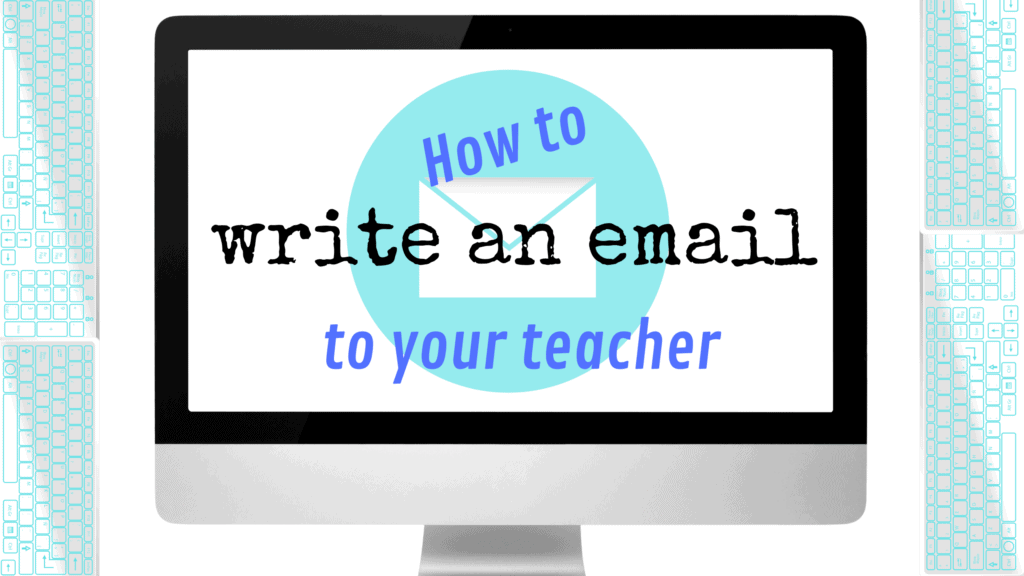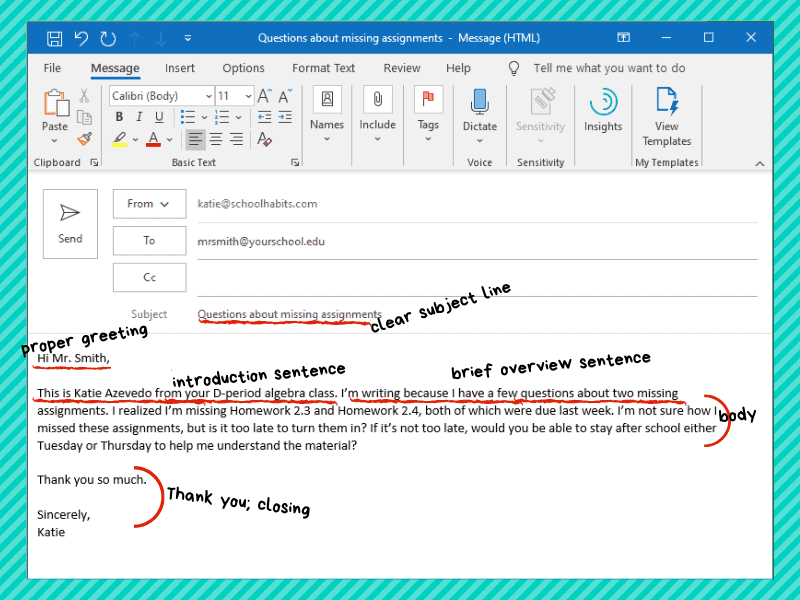How to write an email to your teacher: Tips, rules and examples – SchoolHabits

By Katie Azevedo, M.Ed.
In most situations requiring you to communicate with your teacher, it is best to talk in person. I advise face-to-face meetings when possible because this reduces the chance of miscommunication. In-person meetings also give us the chance to communicate via body language, which is important if you struggle with verbal expression.
However, there are times when face-to-face meetings aren’t possible and you have to write an email instead. For these reasons, you need to know how to write an email to your teacher so that your message is clear and respectful, and also so that you get a response that addresses your concerns.
If your email is unclear and your questions are indirect, you won’t likely get the clear and direct answers you’re seeking — makes sense, right?
Knowing how to write an email to your teacher isn’t just a school-skill; eventually you’ll be writing emails to your boss, to your co-workers, and to other high-rollers. And because you can’t hit “unsend,” you better get it right the first time. If you’re out of school and in the workforce, these email tips, rules and examples apply to you as well.
Okay, onto the rules, the dos and the don’ts.
Mục lục bài viết
How to write an email to your teacher (or to your boss, colleague, principal, etc.)
1. Repeat after me: an email is not a text message!!!
2. Repeat after me: an email is not a novel or an epic poem.
3. Always enter in a subject line. Never leave this field blank. Keep it short and to the point, basically like giving your email a “title.” Don’t be creative, don’t use capital letters (no need to SHOUT), and avoid exclamation points unless it’s an actual emergency … in which case….call 911?
Examples of good subject lines:
- Retaking Monday’s test
- Staying after school this week
- Question about tonight’s homework
- Scheduling a time to meet
Examples of terrible subject lines:
- [no subject]
- WHAT DID I MISS???
- Help!!!!
- i lost my homework and i dont know where to get another copy can you send me another one
4. Use a proper greeting. In fancy language, this is called a salutation. I’m not fancy. In most scenarios, when writing an email to your teacher, you will use “Dear Ms. Smith” – or whatever your teacher’s name is. If you have had your teacher for more than a few weeks, it is okay to use “Hi Ms. Smith.” In either case, always close your salutation with a comma.
Examples of good email greetings:
- Dear Mr. Smith,
- Hi Mrs. Jones,
Examples of bad email greetings:
- [blank]
- Hey!!
- What’s up.
5. Introduce yourself. Unless you’re in elementary school and you only have one teacher, the first sentence of your email should clearly and directly state who you are. Don’t skip this step even if your email address contains your name. Keep this information basic and relevant (your teacher/boss doesn’t need to know your shoe size). Do not write more than one sentence.
Examples of good introductory sentences:
- This is Maria Ricci – I am in your A-period chemistry class.
- This is Chrissy Holmes, and I am in your Tuesday night Economics 101 lecture.
6. Write a brief overview sentence. This is an important, simple, single sentence that clearly states why you are writing the email. It should be similar to your subject line. If this sentence doesn’t match your subject line, go back and edit your subject line.
Examples of good overview sentences:
- I’m writing to you because I was absent on Tuesday and I have some questions about what I missed.
- I’m emailing you to follow up about our conversation we had after class yesterday.
- I’m writing to you because I’m looking for some extra help with the material we covered this week.
7. Write the email body. This is where you state your message and/or ask your questions, and is the whole reason you are writing. Be direct, be clear, and be brief. Ideally, this section should be five sentences or less. If you have multiple questions, use bullet points. If your sentences are long, then use extra line breaks (paragraphs) to separate the text into smaller chunks. (See the extra tips below for more about paragraph size and readability.)
8. Thank your teacher/boss and close out the email. Again, keep this part of your email brief.
Examples of good email closures:
Thank you! Sincerely, Meggan Meggles
I appreciate your help. Billy Bob
9. Proof before sending. Don’t skip this step! Read the email aloud to yourself to catch any funky parts, and review the email for spelling errors or word-choice errors. For the love of everything holy, capitalize your “I”s.
 Here’s an example email, using and identifying all the steps from above.
Here’s an example email, using and identifying all the steps from above.
Now that you know how to write an email to your teacher (or boss), consider the following tips as well.
1. Keep paragraphs to no more than four-ish sentences each.
2. Limit exclamation points. If you simply MUST use one, limit yourself to one exclamation point per email.
3. Avoid blame and take responsibility. If you’re emailing your teacher about an issue you have with your grade or about a problem you’re having, be careful with your wording. Instead of “I don’t get why you gave me an F!” you could write “I got an F on the assignment, and I’m hoping you could help me understand what I did wrong.” Taking ownership is a much better approach and will increase the chances of your teacher helping you.
4. For high-stakes emails – like if you’re emailing your principal or boss – send the email to yourself first. Doing so gives you one last chance to proof it for dumb mistakes and/or errors in tone.
5. Keep it short. Any email longer than 10-12 sentences is better off as a phone call or an in-person meeting
6. Don’t overdo formatting. Avoid colors, weird fonts, all-capital letters, and excessive bold and italics. An appropriate place to use bold might be to highlight dates and times, like in the following example:
Would you be able to meet with me on Tuesday, November 20th at 2:00?
7. Avoid jokes and sarcasm. Save the humor and sarcasm for in-person conversations, as it’s easy for the recipient to misinterpret your tone without hearing your voice or seeing your body language / facial expressions.
Emailing is an effective and efficient form of communication when done correctly. So keep it simple, keep it respectful, and PROOFREAD!
Here are the 4 pillars of email management for students. If you’re overwhelmed in your inbox, follow these 4 steps.
If you struggle with asking for help, here are some key tips for you.
Subscribe to ReportCard Newsletter!
Get your FREE download of 25 School Habits and Hacks when you sign up for our monthly newsletter featuring awesome school tricks and tips
I agree to have my personal information transfered to MailChimp (
I agree to have my personal information transfered to MailChimp ( more information
I will never give away, trade or sell your email address. You can unsubscribe at any time.











